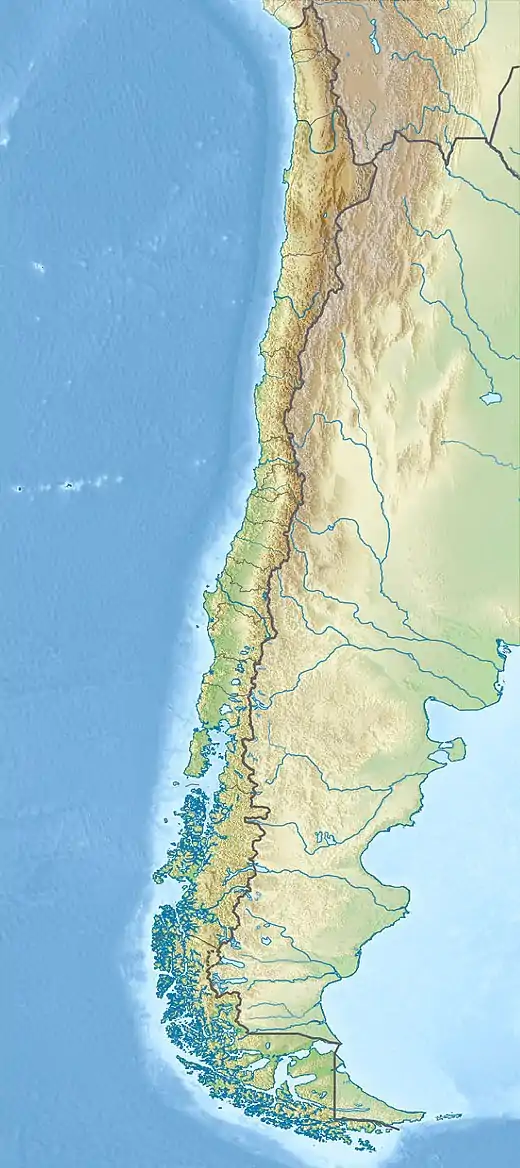| Arauco Basin | |
|---|---|
| Cuenca de Arauco | |
 Arauco Basin is located in the westernmost part of central Chile | |
 | |
| Coordinates | 37°05′S 73°10′W / 37.083°S 73.167°W |
| Etymology | Arauco Peninsula |
| Location | Southwestern South America |
| Country | |
| State(s) | Bío Bío Region |
| Characteristics | |
| On/Offshore | Both |
| Boundaries | Accretionary prism of the Chile trench (W) Accretionary complex intruded by the Coastal Batholith of central Chile (E) |
| Area | ~8,000 km2 (3,100 sq mi) |
| Hydrology | |
| Sea(s) | Eastern Pacific Ocean |
| Geology | |
| Basin type | Forearc basin |
| Orogeny | Andean |
| Age | Maastrichtian-Pliocene |
| Stratigraphy | Stratigraphy |
| Field(s) | Chilean coal |
The Arauco Basin (Spanish: Cuenca de Arauco) is a sediment-filled depression –a sedimentary basin– in south-central Chile. In the context of plate tectonics it is classified as a forearc basin. The basin has an approximate area of 8,000 square kilometres (3,100 sq mi) and at its deeper parts the surface of its sedimentary fill reaches 200 metres (660 ft) below sea-level.[1] The basin is interpreted as being part of an uplifted part of the continental shelf.[2] To the west it bounds an active accretionary prism that lies next to the Chile trench and to the east it bounds metamorphic basement representing a fossil Paleozoic accretionary complex that has been intruded by the Coastal Batholith of central Chile.[3]
Traditionally the centre of coal mining in Chile, large-scale coal mining in Arauco Basin ended in the 1990s.[4] Given a high density of geological faults that have displaced the coal beds and the thin nature of these (less than one metre) mining activity in Arauco Basin has proven difficult to mechanize.[5]
Stratigraphy
The sedimentary fill has a maximum thickness of ca. 2,000 metres (6,600 ft). Parts of the basin are on land in Arauco Peninsula where Eocene coal-bearing rocks of marine and continental origin and Eocene age are exposed. On top of these rocks and toward the centre of the peninsula Miocene and Pliocene sedimentary rocks exists. Towards the east Cretaceous sedimentary rocks crop out.[2] The sedimentary formations defined in Arauco Basin include:
| Name[3][6] | Environment[6][7] | Age[6][8] | Lithology[6] | |
|---|---|---|---|---|
| Tubul Formation | Marine | Pliocene | Sandstone, siltstone | |
| Ranquil Formation | Marine | Miocene–Pliocene | Conglomerate, sandstone, siltstone, shale | |
| Lebu Group | Millongue Formation[note 1] | Marine and continental | Eocene | Shale, siltstone |
| Trihueco Formation | Marine and continental | Eocene | Sandstone, shale, coal | |
| Boca Lebu Formation | Marine | Eocene | Clay-rich and calcareous siltstone, sandstone | |
| Curanilahue Formation | Marine and continental | Paleocene | Massive sandstone, coal, clay-rich sandstone | |
| Quiriquina Formation | Marine | Late Maastrichtian | Sandstone, conglomerate | |
Pliocene Tubul Formation is the oldest formation in the basin that has not been folded. It lies on an unconformity that cuts across all other formations of the basin. At present it reaches 100 metres (330 ft) above sea level in some locations and is dissected by a number of small valleys.[6] The base of the Ranquil Formation is the so-called “main unconformity” which is thought to have formed by erosion during a period of tectonic inversion.[3]
Tectonic evolution
A three-stage model of evolution has been proposed for the Arauco Basin. First a phase of extension in the Late Cretaceous and Paleogene. Then a basin inversion lasting from the Middle Eocene to the Miocene causing the uplift and erosion that created the “main unconformity” and finally a post-inversion phase of strike-slip faulting in the Pliocene and Pleistocene.[3] The subduction of the Mocha Fracture Zone under the basin that begun about 3.6 million years ago is believed to have caused the uplift of the basin plus some further tectonic inversion and contraction.[3]
See also
Notes
References
- ↑ González, Eduardo (1989). "Hydrocarbon resources of the coastal zone of Chile". In Ericksen, G.E.; Cañas Pinochet, M.T.; Reinemund, J.A. (eds.). Geology of the Andes and its relation to hydrocarbon and mineral resources. pp. 383–404.
- 1 2 Mordojovich, Carlos (1981). "Sedimentary Basins of Chilean Pacific Offshore". American Association of Petroleum Geologists Studies in Geology. 12: 732–749.
- 1 2 3 4 5 Becerra, Juan; Contreras-Reyes, Eduardo; Arriagada, César (2013). "Seismic structure and tectonics of the southern Arauco Basin, south-central Chile (~ 38°S)". Tectonophysics. 592: 53–66. Bibcode:2013Tectp.592...53B. doi:10.1016/j.tecto.2013.02.012.
- ↑ Explotacion Reservas. CNE. Accessed on September 10. 2012.
- ↑ Carbón mantiene su sitial en Chile
- 1 2 3 4 5 García A., Floreal (1968). "Estratigrafía del Terciario de Chile Central". In Ceccioni, Giovanni (ed.). El Terciario de Chile Zona Central (in Spanish). Santiago de Chile: Ediorial Andrés Bello.
- ↑ Late Cretaceous Belonostomus (Pisces, Actinopterygii, Aspidorhynchidae) from Algarrobo, Chile, with comments on aspidorhynchid paleodistribution in South America
- ↑ Le Roux, J.P.; Nielsen, Sven N.; Kemnitz, Helga; Henriquez, Álvaro (2008). "A Pliocene mega-tsunami deposit and associated features in the Ranquil Formation, southern Chile" (PDF). Sedimentary Geology. 203 (1): 164–180. Bibcode:2008SedG..203..164L. doi:10.1016/j.sedgeo.2007.12.002. Retrieved 11 April 2016.
- ↑ Palma-Heldt, S.; Quinzio, L.A.; Bonilla, R.; Cisterna, K. (2009). Implicancias estratigráficas del primer registro de Notofagadites en el Paleógeno de la Cuenca de Arauco, Región del Bío-Bío, Chile (PDF). XII Congreso Geológico Chileno (in Spanish). Santiago, Chile. Archived from the original (PDF) on August 18, 2016.